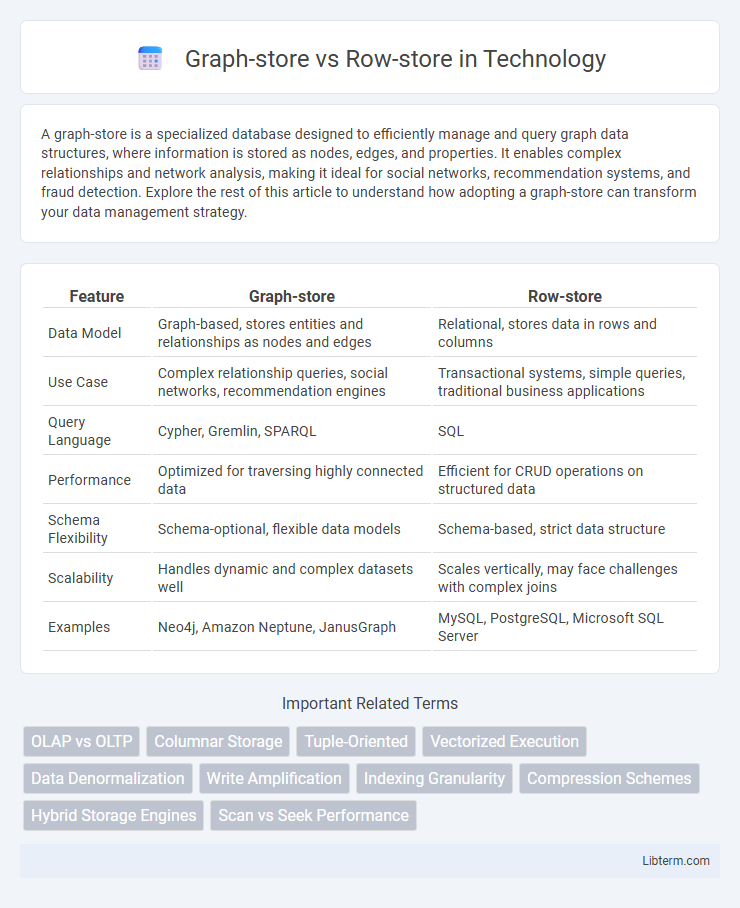A graph-store is a specialized database designed to efficiently manage and query graph data structures, where information is stored as nodes, edges, and properties. It enables complex relationships and network analysis, making it ideal for social networks, recommendation systems, and fraud detection. Explore the rest of this article to understand how adopting a graph-store can transform your data management strategy.
Table of Comparison
| Feature | Graph-store | Row-store |
|---|---|---|
| Data Model | Graph-based, stores entities and relationships as nodes and edges | Relational, stores data in rows and columns |
| Use Case | Complex relationship queries, social networks, recommendation engines | Transactional systems, simple queries, traditional business applications |
| Query Language | Cypher, Gremlin, SPARQL | SQL |
| Performance | Optimized for traversing highly connected data | Efficient for CRUD operations on structured data |
| Schema Flexibility | Schema-optional, flexible data models | Schema-based, strict data structure |
| Scalability | Handles dynamic and complex datasets well | Scales vertically, may face challenges with complex joins |
| Examples | Neo4j, Amazon Neptune, JanusGraph | MySQL, PostgreSQL, Microsoft SQL Server |
Introduction to Data Storage Architectures
Graph-store architectures organize data as nodes and relationships, enabling efficient traversal and complex queries in connected datasets like social networks or recommendation engines. Row-store databases store data in rows, optimizing transactional operations and fast access to complete records, commonly used in traditional OLTP systems. The choice between graph-store and row-store depends on the application's data relationships and query patterns, impacting performance and scalability.
What is a Row-Store Database?
A row-store database organizes data by storing entire rows together in physical storage, optimizing transactional workloads and fast write operations. Each row contains all columns for a record, making it efficient for queries requiring access to many columns of few rows. This structure contrasts with column-store databases, which store data by columns, benefiting analytical queries and read-heavy operations.
What is a Graph-Store Database?
A Graph-Store database is designed to efficiently manage and query complex relationships between data entities by representing information as nodes, edges, and properties, enabling intuitive modeling of interconnected data. Unlike traditional Row-store databases, which organize data in tables with rows and columns optimized for transactional workloads, Graph-Store databases excel in use cases such as social networks, recommendation engines, and knowledge graphs by providing rapid graph traversal and pattern matching capabilities. Popular Graph-Store databases include Neo4j, Amazon Neptune, and Microsoft Azure Cosmos DB, each leveraging graph algorithms and index-free adjacency to deliver high-performance relationship queries.
Key Differences Between Graph-Store and Row-Store
Graph-store databases optimize data representation through nodes, edges, and properties to effectively manage complex relationships, enabling faster traversal and querying of interconnected data compared to row-store systems. Row-store databases organize data in fixed rows within tables, providing efficient operations for simple, tabular, and transactional workloads but lacking native support for relationship-centric queries. The key differences lie in graph-store's ability to perform recursive searches and relationship analytics natively, whereas row-stores excel in structured, indexed data retrieval and transactional consistency.
Data Modeling: Graph-Store vs Row-Store
Graph-store databases excel in handling complex, interconnected data by directly modeling relationships as edges and nodes, enabling efficient traversal and querying of networked information. Row-store databases organize data in a tabular format with rows representing records and columns as attributes, optimizing transactional operations but limiting flexible relationship representation. This fundamental difference in data modeling impacts performance, scalability, and query complexity depending on use cases such as social networks or traditional business applications.
Query Performance Comparison
Graph-store databases excel in handling complex, interconnected data queries by efficiently traversing relationships using index-free adjacency, resulting in faster query execution for relationship-heavy workloads. Row-store databases optimize for transaction processing with sequential data storage but suffer performance degradation in multi-join queries due to extensive join operations and I/O overhead. Benchmark studies show graph-stores outperform row-stores by orders of magnitude in querying deep joins and recursive relationships, making graph-stores ideal for social networks and recommendation systems.
Use Cases: When to Choose Graph-Store
Graph-stores excel in managing highly interconnected data and complex relationships, making them ideal for social networks, recommendation engines, and fraud detection systems. They enable efficient traversal of relationships and pattern matching that row-stores struggle to perform, especially in queries involving many-to-many relationships. Choose graph-stores when your use case demands dynamic schema evolution, real-time analytics on network structures, or deep link analysis.
Use Cases: When to Choose Row-Store
Row-store databases excel in transactional systems requiring fast, efficient writes and updates, such as online transaction processing (OLTP) applications in banking or e-commerce. They are ideal when workloads involve frequent single-record access and modifications, supporting high concurrency and low latency for point queries. Applications with a structured schema, strict ACID compliance, and the need for quick insert, update, and delete operations benefit most from row-store architecture.
Scalability and Flexibility Considerations
Graph-store databases excel in scalability by efficiently managing highly connected data through native graph structures, enabling dynamic schema evolution and flexible relationship modeling. Row-store databases offer strong horizontal scalability for transactional workloads but often face challenges handling complex joins and evolving data models compared to graph-stores. Flexibility in graph-stores is enhanced by their ability to represent intricate networks and adapt to changing data relationships without costly schema redesigns.
Future Trends in Data Storage Architectures
Graph-store databases optimize complex relationship data by enabling efficient traversal and querying of interconnected entities, while row-store databases excel in transactional processing with straightforward, tabular data. Future trends in data storage architectures emphasize hybrid models combining graph and row-store capabilities, leveraging machine learning for adaptive schema design, and enhancing real-time analytics through in-memory processing. Advances in distributed graph processing and graph query optimization will further accelerate the adoption of graph-store systems alongside traditional row-store databases in scalable, multi-model environments.
Graph-store Infographic

 libterm.com
libterm.com